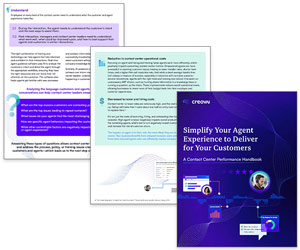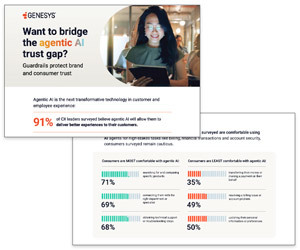Dr Nicola Millard of BT shares some of her original research into contact centre trends and explains how they might shape the future of customer experience.
Ten years ago, we started tracking the behaviours and preferences of customers through our global ‘Autonomous Customer’ research.
Back in 2010, the contact centre of 2020 seemed to be as futuristic as “Star Trek”. We imagined that our personal bots would be negotiating with company bots to get the best price, or solve our customer service issues without us having to bother to do anything as quaint as lifting a phone, or sending an email. Life would be easy.
We were wrong.
Ten years on, this isn’t quite the road we find ourselves on. We’ve asked 6,000 customers across 12 countries about their views on customer experience with organizations both large and small and the picture they paint is less “Star Trek”, and more “Back to the Future”.
The Shock of the Old
Far from being condemned to the history books, voice remains the most important form of customer contact. It is closely followed in preference by another old technology: email.
Organizations have repeatedly tried to direct customers to self-service alternatives. But customers aren’t having it. The question is why?
The clues lie in the autonomous customer data.
It is clear that customers want an easy life, with three in four saying they buy more from companies that make it easier to do business with them. The same number (three in four) like self-service because it puts them in control.
So, what we can gather from this is that customer experience still matters. In fact, 41% say they have stopped partly or completely using two brands or more because of poor customer experience or service.
The trouble is that only one in five rate digital experiences as “excellent”. Digital experiences simply aren’t delivering the quality and usability that customer expect.
Two thirds of customers say that there is not enough help available on organizations’ websites or apps and 77% want a phone number on every web page or app.
For more on why contact centres struggle to shift customers from one channel to another, listen to the following episode of The Contact Centre Podcast, which includes a conversation with Nicola herself.
The Contact Centre Podcast – Episode 6:
Channel Shift: How Can We Safely Move Customers From One Channel To Another?
For more information on this podcast visit Podcast: Channel Shift: How can we safely move customers from one channel to another?
The Phone Is Dead; Long Live the Phone
Voice remains universally the number-one contact channel across the 12 countries involved in the survey. After all, 77% of customers surveyed phoned a contact centre last year and 58% percent would rather phone an organization than use any other channel.
Also, despite popular belief that millennials (25- to 34-year-olds) don’t use the phone, they came out as the biggest age group using the channel, closely followed by the over-65s.
Voice has become the primary escalation channel when digital channels fail – which is why on-hold messages telling us “that you can do this online” are incredibly frustrating.
Whereas Facebook or Twitter might have been regarded as escalation points in previous years, only 38% believed that social media was the best way of getting an urgent customer service issue rectified in this year’s survey (security concerns and the public nature of social media have contributed to its decline).
The phone’s other big advantage is that it is well equipped to tackle emotiveness and complexity. 59% say that, when they ring, they have a more complex issue.
These “customers-in-crisis” inevitably put pressure on the contact centre. Average call handle times go up in the face of complexity, and the pressures on contact centre agent skills increase.
Since many customers start their journey on digital channels, they can often have more up-to-date information, know what’s on the website, or know more about products and services than the agents serving them.
Add to that the pressures of having a conversation with a customer whilst often navigating a myriad of systems, you can see that the life of the phone agent is not getting any easier anytime soon. AI may help them, but it is unlikely to replace them.
For more on the current state of contact centre AI, read our article: Customer Service AI: Where Are We Now?
Messaging Mania
In terms of growth, the clear winner over the past 10 years has been messaging in all its myriad forms.
As customers embraced channels such as WhatsApp and Messenger, businesses followed suit and started moving into text-based comms. 2017 saw messaging surge in popularity as a contact channel by 20%.
It hasn’t seen that level of growth in this year’s survey.
Webchat, although welcomed by customers, can lead to a stilted conversation if agents are on multiple concurrent chats.
Asynchronous messaging – from email to WhatsApp – is growing in popularity because it puts customers in control. Asynchronous contact can be a bit of a nightmare to schedule into the contact centre, though.
Once chat is mentioned, it is almost inevitable that chatbots stick their artificially intelligent heads over the parapet.
At the peak of the chatbot hype cycle in 2017, 73% of customers thought that “bots would improve the customer experience”.
But high expectations have now clashed with reality and that figure is down to 58% as bots haven’t necessarily delivered on their promise. This underlines that the need to combine the human and the machine is paramount.
Bots could be considered to be “IVR for digital” – triaging and routing customers to their goal and ensuring that human agents can pick up when the algorithms hit a dead end.
Intelligent voice assistants such as Alexa, Siri and Cortana could also potentially fuel a further increase in voice contact.
If your customers hit a “I’m sorry I don’t understand” dead end, they are likely to stay on the voice channel and instruct the assistant to “ring the contact centre” rather than switch to another channel.
Again, the key is to ensure that experiences are integrated and customers don’t have to repeat themselves if they are transferred to a human agent.
The Shock of the New
Newer channels have also had their moments over the past ten years.
In 2010, social media looked like it was going to dominate future customer service interactions, but it has made little headway in the majority of sectors (with the notable exceptions of travel and retail).
It is still strong for brand awareness, but the proportion of consumers saying social media is the best way of getting emergency support has declined from 2015. However, its place as a last-resort channel for complaints has increased from 6 percent in 2010 to 25 percent in 2019.
Video was another channel which showed potential for future growth. We are using applications such as Facetime and Skype to talk to each other on a daily basis, but that doesn’t seem to have made the transition into the B2C space.
Only 6% of customers said they had used it in the last six months. Again, there are notable exceptions – with niche areas such as remote diagnostics, expert financial advice and healthcare seeing some traction.
The most intriguing area for future growth is around personalized and proactive experiences. This is a trend underpinned by artificial intelligence and customer data.
As customers share more about themselves, companies can use that data to be more proactive than reactive to customer needs – a “meconomy”.
Eight out of ten customers expect organizations to use AI to offer personalized and proactive customer experiences (a rise from 68 percent in 2017). If this is done appropriately, it allows contact centres to manage demand, rather than have demand manage them.
Appropriateness is all about understanding what messages people want to see, what channels they want to see them on, and what time they are mostly likely to want to see them. This is all based on customers’ willingness to share data, as algorithms don’t work by magic.
Imagine if your friend keeps tapping you on the shoulder to tell you things you don’t really want to know. You would rapidly turn around and punch them.
The digital equivalent is withdrawal of consent to use personal data. In a world of the Internet of Things and “smart” everything, the “meconomy” is a key factor to consider.
What Do the Next Ten Years Hold?
My crystal ball is broken, so a picture of the contact centre of 2030 is as elusive as the one of 2020 was back in 2010.
Customers do seem to have an appetite to engage with organizations over digital channels, and AI is likely to fuel this growth.
However, these channels need to deliver easier and better customer experiences if they are to be embraced by customers.

Older channels, such as voice and email, are currently propping up newer ones because they are familiar, reliable ways to solve more complex and emotive issues.
For now, anyway, the rumours of the phone’s death have been greatly exaggerated (to misquote Mark Twain).
Written by: Dr Nicola J. Millard, Principal Innovation Partner at BT
For more on contact centre predictions and trends, read these articles next:
- Why Immersive Experiences Are the Future of CX
- What Will Agent Roles Look Like in 2035?
- What Will WFM Roles Look Like in 2035?
Author: Nicola Millard
Reviewed by: Hannah Swankie
Published On: 8th Apr 2020 - Last modified: 23rd Sep 2025
Read more about - Customer Service Strategy, Artificial Intelligence (AI), Customer Service, Editor's Picks, Nicola Millard, Predictions, Service Strategy, Trends










































